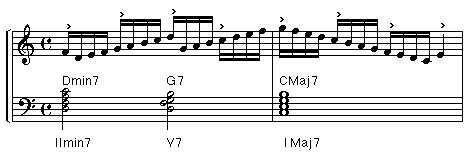Always avoid playing the three chords in root position as shown above. The shifts up and down from one chord to the next sound very amateurish.Instead alternate voicings, for example shown below, where the II and I chords are played in root position and the V chord is played in 2nd inversion. (For chord voicings see Lesson 10).
This produces a very smoothly voiced chord sequence.
Audio 7.5

Fluency No.3 is based on the IIm7-V7-Imaj7 chord progression and covers all twelve keys.
The right hand plays a scale run, the left hand plays the IIm7 - V7 - Imaj7 scale-tone chord progression that is derived from the same scale.
Audio 7.6

This is a good Fluency exercise and at the same time teaches you the the IIm7 - V7 - Imaj7 chord progression and its underlying scale in all keys.
There is a Play-a-Long tracks (P-a-L) for Fluency No.3 included in this Course.
Use it after you have practised the exercise for a while and feel confident with it.
As a general rule play closed position chords (when all chord tones fall within the span of 1 octave, usually played with one hand) so that the bottom note of the chord voicing falls within this range:
 Chords played below this range sound 'muddy', chords above this range start to sound 'tinny'. |